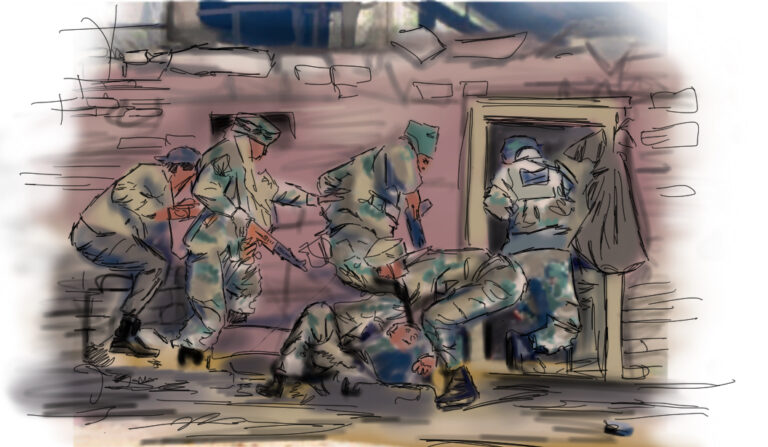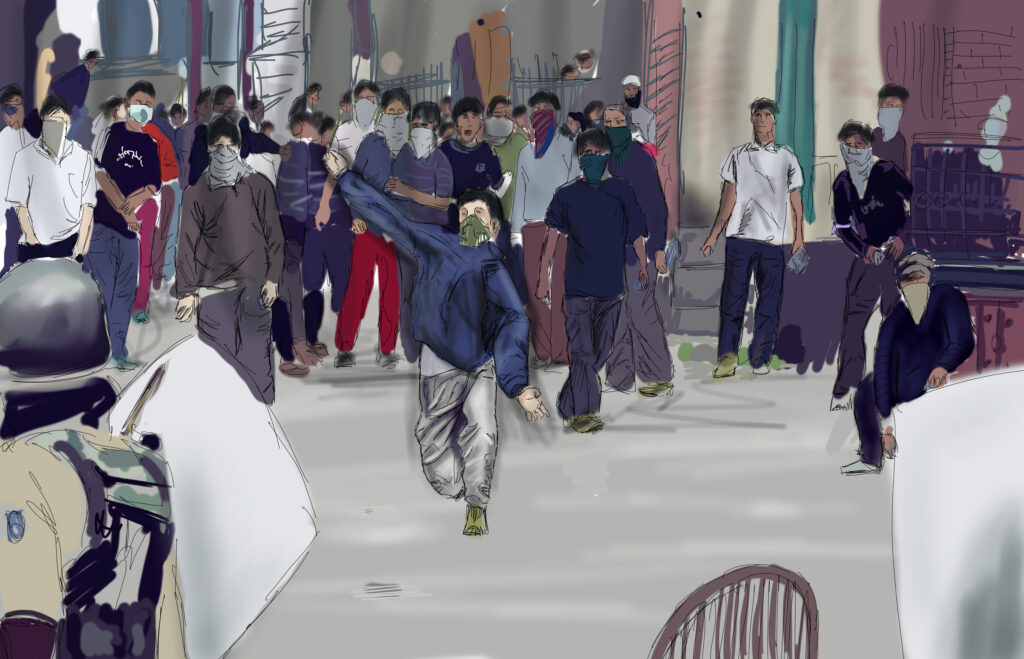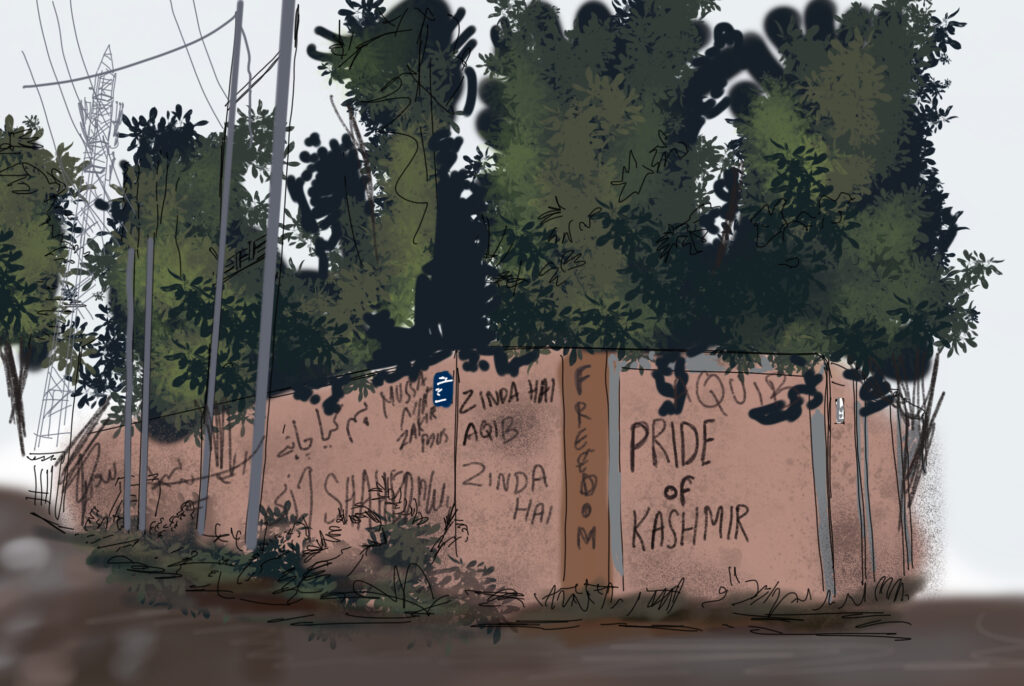Life Under Occupation: India Occupied Kashmir
By Syeda Rabe’a Bukhari
Womanhood is beyond adulthood. I have lived full lives of a martyr, a teenager killed in street by a “stray bullet”, a maiden with a face punctured with pellets, a young lady raped and killed on her wedding night, a newly wed pulling grass out of her husband’s grave in fits of anguish and hysteria, a mother searching since 20 years for her disappeared son, a grandmother rolling her tasbih- one bead, one martyr, years of oppression and resistance sitting under the layers of wrinkles set on her aging face- awaiting deciphering, awaiting freedom. I am yet to reach womanhood. Our bars are set high. Yet I feel over lived.
I consider it a privilege getting to live under the mighty canopy of walnut trees- even when my entire childhood was spent playing under their shade. I am not getting my childhood back. But somehow- after almost 22 years- steady wings of time have carried me back to reminisce- again under the mighty canopy of walnut trees.
I went to a local village school in Baramulla district of Kashmir valley- my hometown. It was a bright summer day. One of those light, carefree school days when recesses were an excursion, an apple or some walnuts in satchel felt like a treasure, homework was the only grief, and only toys broke.
This particular day, I came back from school during recess, ran into the house for lunch and asked for my naani (grandma). My aunt told me she was at a neighbors’ place for taaziyat (offering condolences). She insisted that I ate my lunch and went back to the school but I rushed out of the house towards the neighbors’.
There, lying on the mud floor under the big walnut tree I witnessed a scene that has since been seared into my mind; I still remember it with vivid detail. The corpse of my uncle, with unmistakable marks of torture clear on his body was surrounded by village mourners. I walked towards my naani, huddled with women mourners nearby, and bundled myself up in her lap. I didn’t cry.
The previous day’s happenings came rushing back. Those days rumours of bhoot (ghosts) roaming the streets, frightening and killing people were doing rounds (which was actually a handiwork of the Indian army to create fear and panic among people). During the day, reports of my older uncle going missing spread throughout the village like wildfire.
He was an imam of the local Masjid. People went in search of him but returned empty handed. Around midnight, the rumor of bhoot roaming the village again intensified. I, along with my father and other family members, rushed to the terrace. It was a full moon night. From there we tried to look for some sign of anyone returning with any news of him; the dense atmosphere of grief and fear was only broken by the howling of dogs in the distance.
Whenever I recall that incident two images flash in my mind: one that of his corpse lying under the walnut tree and another of his wailing, inconsolable daughter. I don’t know how this incident impacted me later, how I processed it or even how I immediately reacted to it. I can’t recall any of that. Except this: That was the day I felt the terror of occupation seep into my bones for the first time.
Growing up in Kashmir — 1990s
The 90’s were a peak period in Kashmiri armed struggle against the oppressive Indian regime. I was born in a small village in Baramulla district where I spent my early childhood. I grew up in an atmosphere of fear and disquiet where people disappeared almost every day. While some returned with arms to fight the Indian oppression, others were found killed in orchards and fields. Terms like crackdown, curfew, hartal, mujahid, mukhbir, identity card, hideout etc were new additions to our everyday lexicon.

Amongst my childhood memories the memory of often waking up to the announcement of a crackdown from a nearby Masjid loudspeaker is most vivid. Crackdown was a collective punishment for an entire village where the Indian army would cordon off an entire area and force the men of the village to assemble at one particular place. Then they would send their soldiers on a search operation who would barge into houses looking for Mujahideen or arms their sympathizers might be hiding.
Women were allowed to stay back in their houses but fearing for their safety, they too would come out in the open and stay close to other neighboring women. A day of crackdown meant an off day at school and these off days were frequent.
Since schooling suffered heavily, I was mostly homeschooled in my early childhood. There were continuous threats to life and property on charges of sheltering and supporting Mujahideen, so my family had to leave the village and migrate to town. We first migrated to Baramulla town and then to Srinagar where I started my formal education. Srinagar seemed a bit calmer than the village and I lost myself in a rather delightful school life for a while. The ugly occupation however made its presence felt day in and day out. There were massacres, protests, killings, rapes, hartals, more killings, encounters, grenade attacks which shaped the memory of our childhood days.
The Frustrated Youth — 2000s
Kashmir has not known peace since its occupation. There were always skirmishes. ‘Collateral damage’ meant lives lost and a perpetual, gradual crumbling of the state. After the visible unrest of the 1990s, the 2000s were supposedly a period of calm and quiet. The reality was that the only thing that had changed was the strategy of suppression and oppression.
Despite all the “peace initiatives” and ceasefire efforts between rebel groups, India and Pakistan, nothing lasted for long — primarily because of the insincerity of the occupier. While these years didn’t see an apparent confrontation between Kashmiris and India, there were enforced disappearances, an increasing influx of Indian military personnel; their obnoxious presence was manifest in civilian spaces and daily harassments at their hands continued.
But the true magnitude of this horrific period came to light in 2008 when Dr Angana Chaterjee, an Indian activist, exposed the existence of mass unidentified graves in Northern Kashmir. Her reports verified the existence of 2700 unknown, unmarked and “mass graves”, holding more than 2,943 bodies across 55 villages in Northern Kashmir.

Scores of our missing men and boys were never found; loved ones could only guess which grave contained which of their missing sons, fathers, grandfathers, husbands, brothers or friends.
2008 and 2010 subsequently saw unrest in the valley when 60+ and 110+ unarmed civilians were brutally killed by the occupational forces on streets. Our exams were postponed, colleges and schools were shut, and shoot at sight orders were announced. The entire population was caged for months together.
You see, even as a young person, I’ve already witnessed multiple lockdowns in my time. Such is life when you’re born Kashmiri.
At that point of time what dreams and aspirations could one nurture but hope to see an end to this bloodshed? My mother wanted to see me as a doctor, my father wanted to see me as an administrator. But I just wanted to help my people- only I didn’t know how. There was this rage, this simmering anguish at the helplessness of my people that frustrated me. I just wanted the occupation to end. Everything else had taken a backseat.
Because I was under no delusions by then; this wasn’t just human rights abuse, this wasn’t just oppression of a minority. It was- is -occupation. Peace can come only when the occupation ends.
Dead Eyes — 2016
The summer of 2016 marked the beginning of a new chapter in the history of Kashmiri struggle which is still being written. Burhan Muzaffar Wani, a young Kashmiri boy in his early 20’s, who dared to rebel against the mighty Indian regime by picking up arms, was killed. His martyrdom struck as a personal loss. He had been representing Kashmiri sentiments and fighting the Indian regime with his life. Every Kashmiri, especially the youth, identified with him.

His killing sparked off large scale protests across the valley and there was a brutal clampdown on protesters by the Indian army which resulted in killing of 2–3 civilians on daily basis on an average. Pellets and bullets that rained on civilians resulted in loss of life and eyesight on mass level. Children as small as 3 years old were showered upon by pellets. It indeed was a difficult time. Personally, the helplessness that the occupation has forced upon us was the greatest source of anger.
Burhan had brought many among the youth hope. He was massively influential on social media. His messages of freedom and pictures of resistance resonated with the sentiments of the youth and reverberated in our minds as if they were memories, not just pixels on screens. His loss brought the youth anger. The receding tides of the Kashmiri resistance finally burst forth in a tsunami.
It was in 2016 that the Indian occupation understood the power of unarmed people. Any freedom of expression for Kashmir would threaten the colonial grip of India. When the Kashmiri youth rose against the occupation after decades of relative silence, India began a comprehensive clamp down of the movement. If Kashmir was ever to be completely captured by them, they would have to erase every trace of the resistance. This was the effort that began following the death of Burhan Wani and everything we’re seeing today are milestones of their progression.
Red Herring 370–2019–2020
Article 370 was never regarded with much gravity by those who strove for Kashmiri self-determination. It served as damage control for the occupation. At first, it guaranteed Kashmir semi-autonomy but gradually all such clauses were changed or removed. Everytime the autonomy was undermined, we were reassured by our ‘special status’. We were still special, weren’t we? By 2019, only two meaningful clauses remained: citizenship and ownership rights. Article 370 was the red herring that India used to distract us from it’s routine and organized oppression of our freedoms.
The article, however it was, was provisional; it wasn’t meant to stay. But its removal was something to be decided by the Kashmiri people. On 5th August, 2019 — a cornerstone of Indian hypocrisy was demolished. There was no more hiding, lying or disguising; India meant to take Kashmir and there was little anyone could do about it.
I will say this, though: the ultimate red herring in Article 370, is in its very revocation. Where we previously fought for independence from the occupation, after 2019, India expected us to forget the dream of independence and fight for the restoration of Article 370 — the perfect distraction for the occupier to divide the resistance and uproot its core.
No serious Kashmiri resistance activist was surprised by the revocation of the article. After all, the planning had been systematic and gradually implemented — all in plain sight. Months earlier, we’d witnessed unexplained disappearances of all our activists and active resistance participants. Political figures were silenced, social good organizations shut down. When Article 370 was scrapped, there was no one to protest it as all of our brave souls were behind bars. It was what came after the scrapping that none of us had thought plausible.
On the midnight of August 4th, the internet was gone. Landlines and mobile networks — gone. Overnight, Kashmir was turned into a prison. The Kashmiri diaspora were severed from their families and no word passed between them. Leaving Kashmir was out of question and coming back was difficult.
My brother came back to Kashmir from Lucknow on the first flight he found. We didn’t know he was coming, he had no way to tell us. When he came home, his eyes were bloodshot. He hadn’t slept in days because of the rumours that said that all Kashmiris had been massacred. We too didn’t know what would become of us.
Writing this now, even a year later, is strange. The reality is alien and I can hardly believe it myself. We were in a complete lockdown for months together and by lockdown, I mean lockdown. We couldn’t go to hospitals or stores. We couldn’t walk our own roads.
After some agonous months, landline phones were restored. Landlines are uncommon in Kashmir and ours was the only one in our neighbourhood. So the first call we received was from our neighbour’s daughter in Germany. She was hysteric and couldn’t stop crying when we answered her call. She too had been haunted by the rumours of a Kashmiri massacre.
In January of 2020, 2G internet was restored which is what we make do with even now. It’s good enough for sending messages and pictures but we can’t make calls or other business activities like the rest of the world can during the pandemic.
The pandemic has been especially hard in Kashmir. For it gave the Indian government the perfect excuse to extend the inhumane lockdown we were already under (we’ve now reached 1 year, 2 months and 12 days). But now it’s allowed them new atrocities; they no longer return the bodies of our dead — our families, martyrs and heroes — and they burn down houses after encounters with rebels. After all, who’s around to stop them?
And this is where things stand now. A population of 10 million lives in limbo. On one hand, we’re facing the beast of Indian occupation for what it really is. On the other, we’re facing it alone, without our leaders, our brave ones and definitely with no help from outside.

India has done very well in telling the world Kashmir’s story as a story of ‘civilization’. Its fake, glossy painting of Kashmir and muzzling of Kashmiri voices had long given it a shield from the eyes of the rest of the world. But after the War on Terror, India was given it a free pass to do as it likes with a population of millions. But pray tell, when an armed force rapes entire localities at gunpoint, captures fourteen-year-old boys and tortures them in jails, burns down crops and houses and takes over schools to store their artillery — who is the terrorist? Then sons of raped women? The sisters of jailed boys? The children barred from their own schools?
It’s important to understand that the struggle in Kashmir is not a ‘majority VS minority’ or a ‘radical’ VS ‘moderate’ narrative — the struggle of Kashmir is that of a land under foreign occupation under immediate threat of ethnic cleansing and cultural genocide.
Kashmiris are stuck. We’re choked for space in our own land, we’re surrounded by military men, we walk under the shadows of occupiers’ guns and we live in constant fear of what tomorrow will bring. Almost everyday I wake up to the news of a new encounter and usually by the end of the day 2–3 boys on an average achieve martyrdom. Residential houses are blown. People are rendered homeless. This has been a routine for the past many years.
Everyday I go for a morning walk and there is this large army camp that I have to pass by. Its very presence alongside our beautiful Chinars is ugly and disturbing. And when I pass by it, I have to hear their whistles and catcalling. The humiliation, the fear and the helplessness of not being able to do something about it is a constant reminder of the occupation we are dealing with. There is a brutal onslaught on our bodies, psyches, memories and spaces- an onslaught always in process. Our sense of time and space has been altered. Just like everything else, the occupation regulates our mourning- those spaces have been eaten up.
But we still hope, just no longer in figures or names. We put our tawakkul in Allah. We do what we can, how, when and where we can but after that we can only resign and pin our hopes to Him. The rise of the Mulsim identity in Kashmiris has been the most liberating hope we’ve seen in years.
We’re resisting. Many of us no longer have anything left to lose. We’re speaking up, we’re fighting with the only thing we have left: our voices. A voice speaks to be heard. We need to be heard, we need our cause to reach round tables. Nobody can ever give justice to the dead, but we can save the living.
“But those who knew that they were going to meet their Lord said, ‘How often a small force has defeated a large army with God’s permission! God is with those who are steadfast.” Quran 2:249
About the author
Syeda Rabe’a Bukhari is a post graduate in English Literature from Jamia Millia Islamia, New Delhi. She currently works with an NGO based in Kashmir.
Links: Twitter
